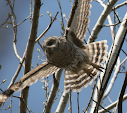
The past week and a half has flown by, and has been notably free of both photography and bird related activities.
Last Friday I was out playing 9 holes at the Coal Creek Golf Course. I didn't have camera gear with me, but did enjoy some avian activity as I walked through the course where I often skirt the perimeter on midday walks. The back nine on that course runs through some fantastically diverse habitat. Much of it is parallel to the Coal Creek Trail system (duh), but there is also a climb through some grassland just off Highway 36 where some bluebirds and warblers were very active. I need to remember my small pair of bins for my next evening round. Highlight species were a Belted-Kingfisher, a flyover by a group of Great Blue Herons, and a perched Swainson's Hawk that allowed me to pass almost directly underneath it as less fortunate members of my foursome spent time sending balls from the rough to the adjacent woods.
Sometimes though, life just gets in the way, and the to dos that get put off can't wait any more. One such to do was a quirky car issue that I had been dealing with for a bit. Last night inconvenience won out and I dropped it off for a first thing in the morning repair. While I was waiting outside the shop for the work to be completed a good sized hawk settled onto a light pole across a fairly busy four lane road. Having my camera bag on my shoulder was fortunate, and I advanced to get the shot below, fearing that the hawk would leave before I got close.

Fairly non-descript from the original angle, but as I looked at my first few frames I noticed something that typically doesn't stand out - the rear talon.

These are often overlooked, but logically have an essential role in capturing prey. As the hawk carries its catch back to which ever perch it will use to eat in safety the rear talon secures the prey item against the forces of drag.
According to the preview I found online for Birds of Prey: An Artists Guide to Understanding Raptors by Floyd Scholtz and Tad Merrick, "On most raptors the largest and thickest talon is on the rear toe (which is called the hallux)..." It continues, "The majority of the killing and grasping power of the foot resides in the rear and inside talons. Understandably these two toes are the thickest and shortest, allowing for much greater leverage and power. These toes also have one less joint than do the middle and outside toes."
How cool is that? I have been fortunate to have the opportunity to work up close with many types of birds of prey, but the details that this book emphasizes for those who seek to reproduce their forms are fascinating. I'll have to keep an eye out for it.

Fortunately this hawk was content to remain perched as I approached the far side of the road and got a better angle for some additional shots. From the front this is an easily identified Swainson's Hawk, but it has far less contrast between the breast band or "necklace" than the majority that I have seen in this area.
If a tiny bit of blood isn't too much for you, look closely at the front view of the talons. This hawk had recently had breakfast. That is always good for the hawk, and even better for the person trying to observe or photograph it. A hawk that has a prey item, or has just eaten is typically more content to tolerate approach than one that is hunting. In this case the perch was on the streetlight post of a four lane road, with all kinds of human activity at the businesses across the street. It didn't pay me more than passing attention, and let me savor its great colors for what would have otherwise been a boring twenty minutes waiting on a car.


No comments:
Post a Comment